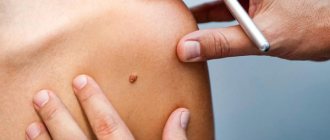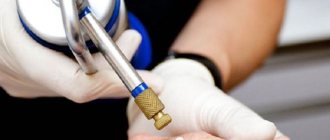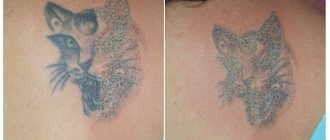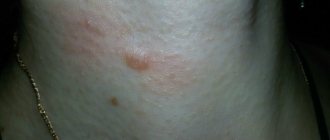Almost every person has at least a few moles on their body. They are benign growths, which in medicine are called nevi. Formations appear on the skin even before puberty.
They can remain on a person’s body throughout his life or disappear unnoticed. There are moles that form in places where they can be touched. Therefore, in order to avoid unpleasant sensations and protect yourself, doctors recommend electrocoagulation of moles.
What is the essence of electrocoagulation?
There are cases when seemingly harmless formations develop into malignant tumors. This can happen due to the influence of many factors, among which a special place is occupied by the effect of sunlight on moles.
Content:
- What is the essence of electrocoagulation?
- About risk factors
- When is electrocoagulation of moles indicated and contraindicated?
- Pros and cons of the procedure
- Mole removal procedure
- Postoperative care
- Possible complications and consequences
Modern medicine has armed itself with various methods of combating unwanted growths that interfere with normal life. The safest treatment methods include electrocoagulation, surgery, laser destruction and radio wave removal. A simple and effective way to protect your own health is electrocoagulation of moles.
The technique is based on the use of high-frequency current discharges, which act as a surgical scalpel. These current discharges make small incisions in the area of the nevus. The tumor is cut off layer by layer.
The device that delivers current discharges is called an electrocoagulator. Electric current affects the desired areas of the skin and prevents bleeding (performing a cauterization function). This technique is considered effective, and with the most minimal risk of infection.
What types of keratomas exist?
There are several types of keratomas:
- seborrheic;
- age;
- senile;
- horny;
- solar;
- follicular.
Seborrheic keratoma is an extremely unpleasant skin disease. In appearance, these are small spots of yellow or brown color, but they tend to increase in size over time, become covered with cracks, and become rough. There may be a feeling of itching and burning, as well as bleeding and pain in the affected areas of the epithelium.
Senile keratomas form in older people. They are yellowish or brown in color and can reach 5–6 centimeters in diameter. Age-related keratomas are usually raised and felt above the skin. They may have an uneven surface, as if covered with pits, resembling a thimble. Most often, these skin growths form on the neck, face and arms.
Senile keratoma usually appears in people over 30 years of age. It becomes covered with a grayish crust. A benign neoplasm is subject to constant inflammatory processes and bleeding.
Recommended articles on the topic:
- Ultrasonic facial peeling is a pleasant and beneficial procedure for your skin
- Redermalization of the skin: all the pros and cons
- Almond peeling for the face: features of the procedure
Horny keratoma gets its name because it looks like an animal horn. Typically, this variant of the skin disease is an advanced form of age-related or seborrheic type keratoma.
Solar keratoma affects those who like to abuse tanning or visiting a solarium. It forms on areas of the skin that are most exposed to ultraviolet radiation - the face, arms, shoulders, chest. Keratoma is colored gray, yellow or brown.
Follicular keratoma appears on areas of the skin covered with hair (head, face). It looks like a nodule, colored gray and reaching 1.5 centimeters in diameter. This is the rarest type of keratoma.
About risk factors
Moles on the body need to be monitored so that they do not develop into a serious disease, such as melanoma. Skin cancer is a common cancer that occurs in people of different age groups. In the early stages of the disease, you can begin an effective course of treatment and defeat the disease.
Risk factors influencing the degeneration of a nevus into melanoma: trauma to the neoplasm, constant and prolonged exposure to the sun, hormonal changes, dysfunction of the endocrine system, genetic predisposition. Doctors warn that if the process of nevus degeneration into skin cancer begins, it will not be easy to stop.
You should consult a doctor if you have the following symptoms:
- changes in the size and shape of the nevus;
- intensive growth of education;
- bleeding from a mole;
- wrinkling and peeling of the neoplasm;
- uneven color of the nevus;
- hair loss around the growth.
If you have one or more symptoms, you should seek help from a dermatologist or surgeon. After undergoing a complete diagnosis of the body, the specialist will decide which method is best to remove the growth.
Characteristic
Spider veins are dilations of the capillaries of blood vessels. On the face they appear in the area of the nose and cheeks. Spider veins are also called telangiectasia.
According to studies, more than 90% of the world's population are “owners” of telangiectasia, which, in turn, combines all types of vascular dilatation on the human body.
The name vascular network appeared due to the fact that dilated capillaries become quite noticeable on the body and form the appearance of a mesh. It is worth noting that such expansion of capillaries does not form without reason. This disease mainly affects women in labor and young mothers; telangiectasia can also be a consequence of a disease such as venous insufficiency.
In the course of the studies, it was revealed that the appearance of the vascular network is not affected by any individual factors or diseases. It has become known that those who are susceptible to chronic varicose veins may not have vascular networks on their body. Thus, we can conclude that the vascular network is not the cause or consequence of any individual diseases, it is a separate problem of the body in each specific case and is often caused by hormonal imbalance.
When is electrocoagulation of moles indicated and contraindicated?
The procedure for removing a mole should be prescribed if there are a number of indications. Before prescribing a manipulation, the doctor must make sure of the nature of the formation, why the formation occurred and what factors influenced this process. For malignant degeneration, surgical intervention is most often used.
People for whom nevus causes discomfort and spoils the aesthetic appearance of the body are prescribed an electrocoagulation procedure.
The manipulation does not take much time from the patient and is completely safe. One of the main advantages of the recovery period is the absence of scars on the skin. If the mole is larger than 1 centimeter, it must be removed through surgery. After the operation, stitches are placed and, alas, marks remain on the skin.
Contraindications for electrocoagulation:
- allergies to drugs that are part of anesthesia;
- individual sensitivity to electrical procedures;
- blood clotting disorder;
- malignant neoplasms (in the case of oncology, other treatment methods are used).
Electrocoagulation of moles is a technique that will allow a person to get rid of growths that spoil the aesthetic appeal of the body. Doctors prefer this manipulation because of its safety, accessibility and effectiveness.
Survey
In order to identify pathological changes in the formation, an optical device is used - a dermatoscope. By applying the device to an area of skin, the doctor can examine in detail the structure of the formation and understand whether it poses a danger to the patient . Based on this, the specialist determines which method of removing the formation is suitable for the patient.
People often come to Melanoma Unit to eliminate cosmetic defects associated with moles, warts and papillomas. For this purpose, an individual method of removing formations is selected, with maximum cosmetic effect.
Our doctors - oncosurgeons, dermatologists - remove moles, papillomas, warts using surgical, radio wave, and laser methods.
All procedures are virtually painless, safe and can be performed in one clinic visit.
Pros and cons of the procedure
Removing nevi using an electrocoagulator is a simple manipulation that has its advantages and disadvantages. If the doctor follows safety precautions during the intervention, then a relapse is unlikely.
The cut growth is sent for histological examination, and the epidermis adjacent to the nevus is removed, thereby minimizing the regrowth of the formation. The advantages also include safety and low cost of manipulation.
The only downside of the operation can be the formation of a scar or scar at the excision site. This is only possible when the procedure is carried out unprofessionally or in case of non-compliance with the recommendations of patients during the rehabilitation period.
Mole removal procedure
No additional preparation is required for electrocoagulation. The manipulation itself takes from 15 to 30 minutes. First, the doctor does an allergy test for medications. If there are no allergic reactions to medications, you can safely proceed to anesthesia. The patient is given local anesthesia or a special cream is applied to the skin. Next, using the device, the mole is excised layer by layer. At the time of removal, the skin at the site of the growth is cauterized. Cauterization of the epidermis and blood vessels occurs due to exposure to very high temperatures. Electrocoagulation allows you to solve the problem of bleeding, swelling and infections.
During the manipulation, a person will not feel discomfort or unpleasant sensations. The patient may only feel a slight tingling sensation in the area where the nevus is excised. After manipulation, a scab (protective crust) forms in its place. The scab protects against infections from entering the wound and prevents bleeding. The wound healing period varies from 7 to 10 days.
Destructive methods for removing keratomas
Compared to removing keratoma with ointments, surgical excision is the fastest and most effective way to eliminate cosmetic skin imperfections. Modern medicine offers several destructive types of treatment for dermatological formations. Methods for removing keratomas are:
- treatment of growths with radio waves;
- removal of keratoma with liquid nitrogen;
- cauterization of tumors with electric current (electrocoagulation);
- laser burning of epithelial defects;
- surgical removal of growths.
The doctor at the clinic helps the patient choose the most effective and appropriate of the listed methods for removing skin defects.
- Radio wave removal of large keratomas
One of the most gentle ways to influence the skin is radio wave removal of keratoma. To perform the operation, a special device is required - surgitron. Narrowly directed radio waves emitted by this device affect different layers of the skin, causing evaporation of intracellular fluid and destruction of the keratoma. Using an applicator, the doctor controls the depth of treatment of the epidermis during the procedure, which helps fight formations of different sizes. To eliminate pain during the session, local anesthesia is used.
Advantages of keratosis removal using the radio wave method:
- minimal impact on healthy skin;
- speed and high efficiency of the procedure;
- absence of complications and scars after manipulations;
- short recovery time for the epidermis;
- possibility of treating large areas of keratoma localization.
- Laser removal of keratomas
Laser correction of skin tumors is an effective method for treating diseases of the dermis, the essence of which is the effect of laser beams on altered epithelial cells and their destruction. Since the laser prevents the opening of bleeding, the risk of complications is minimal. This technology involves exposing the skin to high temperature, which blocks the development of bacteria and infection. Healthy skin is not subject to the destructive effects of the laser, so there are no scars left after the procedure. Laser keratosis removal is suitable for patients who have increased sensitivity to light or dark, tanned skin.
- Removal of keratomas with liquid nitrogen
Cryotherapy, or exposing the skin to liquid nitrogen, is another effective way to remove tumors. Using a special apparatus or a cotton pad, liquid nitrogen is applied to problem areas, which leads to instant freezing of pathologically altered epithelial cells. This technique provides high aesthetic results, since under the influence of cold, keratoma cells fall off, and healthy skin is not injured.
However, there is a possibility of relapse of the disease, since the root of the tumor is not completely removed. If the keratomas are small and there are not many of them, removal can be done in one session. Foci of accumulation of neoplasms should be treated with nitrogen over several visits to the dermatologist. At your appointment, a qualified doctor will be able to assess the extent of skin damage and prescribe the required number of procedures.
We recommend
Laser aesthetic cosmetology: the perfect technique for an ideal appearance Read more
Cryotherapy has a significant drawback. After a session to remove keratoma with liquid nitrogen, a bubble forms on the skin, which does not go away for several days. It is important not to damage this area during hygiene procedures, as this may disrupt the healing process. Puncture of the bladder may contribute to the development of wound infection. If the resulting bubble causes significant inconvenience to the patient, it is necessary to consult a doctor who will treat the wound and apply a sterile bandage.
The nitrogen therapy procedure is contraindicated for people prone to allergic reactions to exposure to low temperatures, with chronic and oncological diseases in the acute stage, and who are carriers of the herpes virus. Infectious and inflammatory processes are also a limitation.
- Electrocoagulation of keratome
Removal of keratomas using electrocoagulation is another modern and effective way to get rid of tumors on the skin. It is especially effective when dealing with fresh growths. If keratomas have appeared a long time ago, coagulation is unlikely to help. The essence of this method is the destructive effect of electric current on keratoma cells, which leads to necrosis of pathological tissues and their loss. This procedure is quite painful, so it is performed using local anesthesia. Electrocoagulation involves removing tumors without affecting healthy epithelial cells. This is especially important if there is a risk of degeneration of a benign tumor into a malignant one.
- Surgical excision of keratoma
The surgical method of excision of keratoma involves performing the procedure using a scalpel. The doctor may prescribe surgery under local anesthesia in the following cases:
- the presence of contraindications for other destructive methods of keratoma removal;
- the process of degeneration of keratoma into a malignant formation;
- large areas of skin damage;
- ineffectiveness of other methods of treating skin diseases.
The surgical method of removing keratoma has a number of disadvantages:
- long and painful postoperative recovery period;
- damage to healthy dermal tissue around the site of keratoma localization;
- risk of wound infection and bleeding;
- the need for suture material;
- scars and scars after surgery.
To speed up the process of tissue regeneration and reduce the risk of infections, the doctor prescribes antibiotics and painkillers to the patient.
Postoperative care
To prevent scars from appearing at the site of excision of the formation, you should not neglect the doctor’s recommendations for caring for the wound. The skin must be treated with special antiseptic preparations (hydrogen peroxide or chlorhexidine).
The excision site should be protected from negative external influences, such as sunlight, and the use of cosmetics is prohibited. Also, it is necessary to ensure that moisture does not get on the skin.
It is not recommended to visit solariums, swimming pools, saunas and steam baths until the wound heals. It is advisable to walk outside on sunny days after lunch or in the evening. There is no need to remove the scab yourself; it will fall off on its own after complete healing. If you follow all the rules and recommendations during the recovery period, you can minimize unwanted skin pigmentation and avoid complications.
Rehabilitation period after keratoma removal
Removal of keratomas by any of the above methods involves a postoperative period, which lasts differently. The longest recovery process is observed after surgery. It can range from 2 weeks to 4 months.
After removing a keratoma using any of the destructive methods, it is important to adhere to the following recommendations:
- avoid contact of water and moisture on the affected area of the skin;
- do not remove the crust on the treated area of the dermis, as this can lead to the appearance of scars, scars and infection;
- try not to touch the inflamed epithelium and not expose it to ultraviolet radiation;
- use medications prescribed by a doctor;
- do not self-medicate, do not resort to traditional medicine unless your doctor approves it.
If you follow these recommendations, the regeneration process will be quick, painless and without complications.
After the keratoma removal procedure, it is important to come to an in-person appointment with a doctor for an examination 10–12 days later. The doctor will be able to evaluate the effectiveness of the applied technique and outline a plan for further action, as well as give recommendations for skin care.
In our clinic, you can remove keratomas using liquid nitrogen, as well as any other methods at an affordable price. After consultation, specialists will select the most suitable procedure and eliminate the skin defect.
Why clients choose Veronika Herba Beauty and Health Center:
- This is a beauty center where you can take care of yourself at a reasonable cost, while your face and/or body will be treated not by an ordinary cosmetologist, but by one of the best cosmetologists in Moscow. This is a completely different, higher level of service!
- You can receive qualified help at any time convenient for you. The beauty center is open from 9:00 to 21:00, seven days a week. The main thing is to agree with your doctor in advance on the date and time of your appointment.
Sign up for a consultation with a specialist by phone +7 (495) 085-15-13
, and you will see for yourself!











